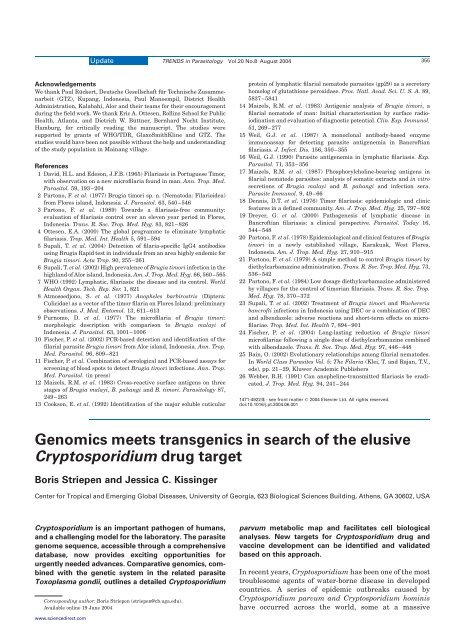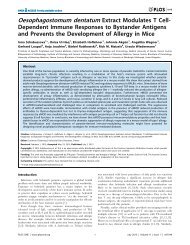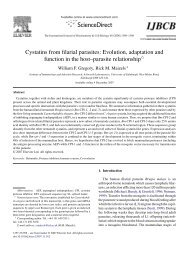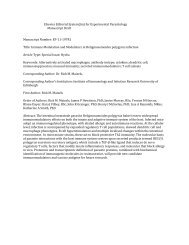Lymphatic filariasis and Brugia timori - Rick Maizels' Group ...
Lymphatic filariasis and Brugia timori - Rick Maizels' Group ...
Lymphatic filariasis and Brugia timori - Rick Maizels' Group ...
You also want an ePaper? Increase the reach of your titles
YUMPU automatically turns print PDFs into web optimized ePapers that Google loves.
Acknowledgements<br />
We thank Paul Rückert, Deutsche Gesellschaft für Technische Zusammenarbeit<br />
(GTZ), Kupang, Indonesia, Paul Manoempil, District Health<br />
Administration, Kalabahi, Alor <strong>and</strong> their teams for their encouragement<br />
during the field work. We thank Eric A. Ottesen, Rollins School for Public<br />
Health, Atlanta, <strong>and</strong> Dietrich W. Büttner, Bernhard Nocht Institute,<br />
Hamburg, for critically reading the manuscript. The studies were<br />
supported by grants of WHO/TDR, GlaxoSmithKline <strong>and</strong> GTZ. The<br />
studies would have been not possible without the help <strong>and</strong> underst<strong>and</strong>ing<br />
of the study population in Mainang village.<br />
References<br />
1 David, H.L. <strong>and</strong> Edeson, J.F.B. (1965) Filariasis in Portuguese Timor,<br />
with observation on a new microfilaria found in man. Ann. Trop. Med.<br />
Parasitol. 59, 193–204<br />
2 Partono, F. et al. (1977) <strong>Brugia</strong> <strong>timori</strong> sp. n. (Nematoda: Filarioidea)<br />
from Flores isl<strong>and</strong>, Indonesia. J. Parasitol. 63, 540–546<br />
3 Partono, F. et al. (1989) Towards a <strong>filariasis</strong>-free community:<br />
evaluation of <strong>filariasis</strong> control over an eleven year period in Flores,<br />
Indonesia. Trans. R. Soc. Trop. Med. Hyg. 83, 821–826<br />
4 Ottesen, E.A. (2000) The global programme to eliminate lymphatic<br />
<strong>filariasis</strong>. Trop. Med. Int. Health 5, 591–594<br />
5 Supali, T. et al. (2004) Detection of filaria-specific IgG4 antibodies<br />
using <strong>Brugia</strong> Rapid test in individuals from an area highly endemic for<br />
<strong>Brugia</strong> <strong>timori</strong>. Acta Trop. 90, 255–261<br />
6 Supali, T. et al. (2002) High prevalence of <strong>Brugia</strong> <strong>timori</strong> infection in the<br />
highl<strong>and</strong> of Alor isl<strong>and</strong>, Indonesia. Am. J. Trop. Med. Hyg. 66, 560–565<br />
7 WHO (1992) <strong>Lymphatic</strong>, <strong>filariasis</strong>: the disease <strong>and</strong> its control. World<br />
Health Organ. Tech. Rep. Ser. 1, 821<br />
8 Atmosoedjono, S. et al. (1977) Anopheles barbirostris (Diptera:<br />
Culicidae) as a vector of the timor filaria on Flores Isl<strong>and</strong>: preliminary<br />
observations. J. Med. Entomol. 13, 611–613<br />
9 Purnomo, D. et al. (1977) The microfilaria of <strong>Brugia</strong> <strong>timori</strong>:<br />
morphologic description with comparison to <strong>Brugia</strong> malayi of<br />
Indonesia. J. Parasitol. 63, 1001–1006<br />
10 Fischer, P. et al. (2002) PCR-based detection <strong>and</strong> identification of the<br />
filarial parasite <strong>Brugia</strong> <strong>timori</strong> from Alor isl<strong>and</strong>, Indonesia. Ann. Trop.<br />
Med. Parasitol. 96, 809–821<br />
11 Fischer, P. et al. Combination of serological <strong>and</strong> PCR-based assays for<br />
screening of blood spots to detect <strong>Brugia</strong> <strong>timori</strong> infections. Ann. Trop.<br />
Med. Parasitol. (in press)<br />
12 Maizels, R.M. et al. (1983) Cross-reactive surface antigens on three<br />
stages of <strong>Brugia</strong> malayi, B. pahangi <strong>and</strong> B. <strong>timori</strong>. Parasitology 87,<br />
249–263<br />
13 Cookson, E. et al. (1992) Identification of the major soluble cuticular<br />
protein of lymphatic filarial nematode parasites (gp29) as a secretory<br />
homolog of glutathione peroxidase. Proc. Natl. Acad. Sci. U. S. A. 89,<br />
5837–5841<br />
14 Maizels, R.M. et al. (1983) Antigenic analysis of <strong>Brugia</strong> <strong>timori</strong>, a<br />
filarial nematode of man: Initial characterisation by surface radioiodination<br />
<strong>and</strong> evaluation of diagnostic potential. Clin. Exp. Immunol.<br />
51, 269–277<br />
15 Weil, G.J. et al. (1987) A monoclonal antibody-based enzyme<br />
immunoassay for detecting parasite antigenemia in Bancroftian<br />
<strong>filariasis</strong>. J. Infect. Dis. 156, 350–355<br />
16 Weil, G.J. (1990) Parasite antigenemia in lymphatic <strong>filariasis</strong>. Exp.<br />
Parasitol. 71, 353–356<br />
17 Maizels, R.M. et al. (1987) Phosphorylcholine-bearing antigens in<br />
filarial nematode parasites: analysis of somatic extracts <strong>and</strong> in vitro<br />
secretions of <strong>Brugia</strong> malayi <strong>and</strong> B. pahangi <strong>and</strong> infection sera.<br />
Parasite Immunol. 9, 49–66<br />
18 Dennis, D.T. et al. (1976) Timor <strong>filariasis</strong>: epidemiologic <strong>and</strong> clinic<br />
features in a defined community. Am. J. Trop. Med. Hyg. 25, 797–802<br />
19 Dreyer, G. et al. (2000) Pathogenesis of lymphatic disease in<br />
Bancroftian <strong>filariasis</strong>: a clinical perspective. Parasitol. Today 16,<br />
544–548<br />
20 Partono, F. et al. (1978) Epidemiological <strong>and</strong> clinical features of <strong>Brugia</strong><br />
<strong>timori</strong> in a newly established village, Karakuak, West Flores,<br />
Indonesia. Am. J. Trop. Med. Hyg. 27, 910–915<br />
21 Partono, F. et al. (1979) A simple method to control <strong>Brugia</strong> <strong>timori</strong> by<br />
diethylcarbamazine administration. Trans. R. Soc. Trop. Med. Hyg. 73,<br />
536–542<br />
22 Partono, F. et al. (1984) Low dosage diethylcarbamazine administered<br />
by villagers for the control of <strong>timori</strong>an <strong>filariasis</strong>. Trans. R. Soc. Trop.<br />
Med. Hyg. 78, 370–372<br />
23 Supali, T. et al. (2002) Treatment of <strong>Brugia</strong> <strong>timori</strong> <strong>and</strong> Wuchereria<br />
bancrofti infections in Indonesia using DEC or a combination of DEC<br />
<strong>and</strong> albendazole: adverse reactions <strong>and</strong> short-term effects on microfilariae.<br />
Trop. Med. Int. Health 7, 894–901<br />
24 Fischer, P. et al. (2004) Long-lasting reduction of <strong>Brugia</strong> <strong>timori</strong><br />
microfilariae following a single dose of diethylcarbamazine combined<br />
with albendazole. Trans. R. Soc. Trop. Med. Hyg. 97, 446–448<br />
25 Bain, O. (2002) Evolutionary relationships among filarial nematodes.<br />
In World Class Parasites Vol. 5: The Filaria (Klei, T. <strong>and</strong> Rajan, T.V.,<br />
eds), pp. 21–29, Kluwer Academic Publishers<br />
26 Webber, R.H. (1991) Can anopheline-transmitted <strong>filariasis</strong> be eradicated.<br />
J. Trop. Med. Hyg. 94, 241–244<br />
1471-4922/$ - see front matter q 2004 Elsevier Ltd. All rights reserved.<br />
doi:10.1016/j.pt.2004.06.001<br />
Genomics meets transgenics in search of the elusive<br />
Cryptosporidium drug target<br />
Boris Striepen <strong>and</strong> Jessica C. Kissinger<br />
Center for Tropical <strong>and</strong> Emerging Global Diseases, University of Georgia, 623 Biological Sciences Building, Athens, GA 30602, USA<br />
Cryptosporidium is an important pathogen of humans,<br />
<strong>and</strong> a challenging model for the laboratory. The parasite<br />
genome sequence, accessible through a comprehensive<br />
database, now provides exciting opportunities for<br />
urgently needed advances. Comparative genomics, combined<br />
with the genetic system in the related parasite<br />
Toxoplasma gondii, outlines a detailed Cryptosporidium<br />
Corresponding author: Boris Striepen (striepen@cb.uga.edu).<br />
Available online 19 June 2004<br />
www.sciencedirect.com<br />
Update TRENDS in Parasitology Vol.20 No.8 August 2004 355<br />
parvum metabolic map <strong>and</strong> facilitates cell biological<br />
analyses. New targets for Cryptosporidium drug <strong>and</strong><br />
vaccine development can be identified <strong>and</strong> validated<br />
based on this approach.<br />
In recent years, Cryptosporidium has been one of the most<br />
troublesome agents of water-borne disease in developed<br />
countries. A series of epidemic outbreaks caused by<br />
Cryptosporidium parvum <strong>and</strong> Cryptosporidium hominis<br />
have occurred across the world, some at a massive





